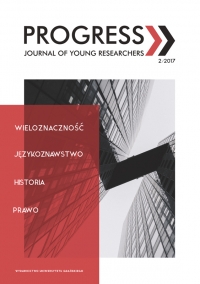“I run; therefore I am”. An interpretation of private diary of Haruki Murakami in light of somaesthetics by Richard Shusterman
Keywords:
Haruki Murakam, Richard Shusterman, personal documents, autothnography, running, somaesthetics, embodied experience, sportAbstract
The aim of the article is to interpret embodied experiences described in the book What I talk about when I talk about running by Haruki Murakami. The analytical frame for this task is the new philosophical and aesthetical movement called somaesthetics, invented by an American thinker Richard Shusterman. Not only the main assumptions of this conception, but also elements of its criticism are presented. Soamesethetics has met with strong response among philosophers, and gained both followers and opponents. Opinions of both sides are described in the article. The subject of this paper imposes its structure. In the first part, basic propositions and terms of somaesthetics are introduced. The second part is devoted to the work of H. Murakami and deeper interpretation of chosen excerpts. To familiarize the reader with content of the book selected quotations have been provided. The article ends with recapitulation of the main conclusions concerning the way Murakami’s work corresponds to Shusterman’s theory.
Downloads
References
Abrams J., 2004, Pragmatism, Artificial Intelligence, and Posthuman Bioethics: Shusterman, Rorty, Foucault, „Human Studies” 27.
Allen-Collinson J., Hockey J., 2006, Seeing the way: visual sociology and the distance runner’s perspective, „Visual Studies. Journal of the International Visual Sociology Association” 21 (1).
Allen-Collinson J., Hockey J., 2015a, Digging in: The Sociological Phenomenology of ‘Doing Endurance’ in Distance-Running, http://www.academia.edu/17203554/Digging_in_The_sociological_phenomenology_of_doing_endurance_in_distance-running_in_W_Bridel_P_Markula_and_J_Denison_eds_Endurance_Running_A_Socio-Cultural_Examination._London_Routledge_pp_227-242 [dostęp: 1.04.2017].
Allen-Collinson J., Hockey J., 2015b, From a Certain Point of View: Sensory Phenomenological Envisionings of Running Space And Place, „Journal of Contemporary Ethnography” 44 (1).
Allen-Collinson J., Hockey J., 2017, Running a Temperature: Sociological-Phenomenological Perspectives on Distance Running, Thermoception and ‘Temperature Work’, http://www.academia.edu/30030393/Hockey_J_and_Allen-Collinson_J_2017_Running_a_temperature_sociologicalphenomenological_perspectives_on_distance_running_thermoception_and_temperature_work_in_A_C_Sparkes_ed_Seeking_the_Senses_in_Physical_Cultures_Sensual_scholarship_ in_action._London_Routledge_42-62 [dostęp: 1.04.2017].
Allen-Collinson J., Vaittinen A., Jennings G., Owton H., 2016, Exploring Lived Heat, ‘Temperature Work’ and Embodiment: Novel Auto/Ethnographic Insights from Physical Cultures, „Journal of Contemporary Ethnography”, http://journals.sagepub.com/doi/pdf/10.1177/0891241616680721. [dostęp: 1.04.2017]
Guerra G., 2002, Practicing Pragmatism: Richard Shusterman’s Unbound Philosophy, „The Journal of Aesthetic Education” Vol. 36, No. 4.
Haskins C., 2002, Enlivened Bodies, Authenticity, and Romanticism, „The Journal of Aesthetic Education” Vol. 36, No. 4.
Higgins K., 2002, Living and Feeling at Home: Shusterman’s ”Performing Live”, „The Journal of Aesthetic Education” Vol. 36, No. 4.
Jakubowska H., Nosal P. (red.), 2017, Socjologia sportu, Warszawa: Wydawnictwo Naukowe PWN.
Jamroziakowa A., 2006, Sztuka życia a kondycja fizyczna człowieka, „Estetyka i Krytyka” 9/10 (2/2005–1/2006).
Jay M., 2002, Somaesthetics and Democracy: Dewey and Contemporary Body Art, „The Journal of Aesthetic Education” Vol. 36, No. 4.
Johnston J. 2004, Refl ections on Richard Shusterman’s Dewey, „The Journal of Aesthetic Education” Vol. 38, No. 4.
Małecki W., 2007, O praktycznych aspektach estetyki Richarda Shustermana – sztuka popularna i somatoestetyka [w:] Wizje i re-wizje: wielka księga estetyki w Polsce, red. K. Wilkoszewska, Kraków: Universitas.
Mullis E. 2006, Performative Somaesthetics: Principles and Scope, „The Journal of Aesthetic Education” Vol. 40, No. 4.
Murakami H., 2010, O czym mówię, kiedy mówię o bieganiu, tłum. J. Polak, Warszawa: Muza.
Nehamas A., 1998, Richard Shusterman on Pleasure and Aesthetic Experience, „Journal of Aesthetics and Art Criticism” Vol. 56, No. 1.
Shusterman R., 1998, Interpretation, Pleasure, and Value in Aesthetic Experience, „The Journal of Aesthetics and Art Criticism” Vol. 56, No. 1.
Shusterman R., 1999, Somaesthetics: A Discpilinary Proposal, „The Journal of Aesthetics and Art Criticism” Vol. 57, No. 3.
Shusterman R., 2002, Home Alone? Self and Other in Somaesthetics and ”Performing Live”, „The Journal of Aesthetic Education” Vol. 36, No. 4.
Shusterman R., 2004, Complexities of Aesthetic Experience: Response to Johnston, „The Journal of Aesthetic Education“ Vol. 38, No. 4.
Shusterman R., 2007, Myślenie poprzez ciało. Rozwinięcie nauk humanistycznych – uzasadnienie dla somaestetyki, tłum. S. Stankiewicz [w:] Wizje i re-wizje: wielka księga estetyki w Polsce, red. K. Wilkoszewska, Kraków: Universitas.
Shusterman R., 2010, Świadomość ciała: dociekania z zakresu somaestetyki, tłum. W. Małecki, Sebastian Stankiewicz, Kraków: Universitas.
Downloads
Published
How to Cite
Issue
Section
License
Copyright (c) 2017 Author(s)

This work is licensed under a Creative Commons Attribution 4.0 International License.

 Academic Scientific Journals
Academic Scientific Journals




